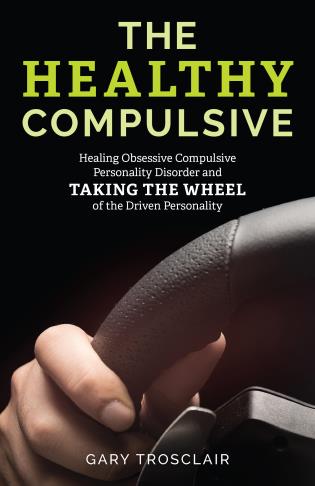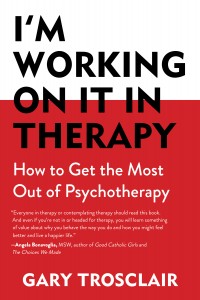There’s so much psychological information and advice out there it’s too much to take in. What’s a compulsive perfectionist to do? We all want to get Better, but don’t have the time to read all the latest news about what’s best for us.
The Healthy Compulsive to the rescue! To make a dent in the pile of material you might feel you have to read to be up on the most recent developments in mental health, here’s a practical review of the relatively new approach to therapy called Acceptance and Commitment Therapy, with brief examples of how to apply it. My review is 129,332 words shorter than the definitive book about it! Not to mention $52 cheaper! And hopefully, not as dry.
Contents
The Holy Grail of Flexibility
Many readers of this blog, and listeners to this podcast, either see, or have been told, that they need to be more flexible. Well, that’s jolly good. But how?
When The Healthy Compulsive book first came out it was enthusiastically reviewed by a psychologist at a teaching hospital. She said that there were similarities between my approach and Acceptance and Commitment Therapy (ACT). I knew little about ACT at the time and decided it was high time I did.
The reviewer was right. Similarities between my approach and ACT include an emphasis on values, being in the present, respecting feelings without being overwhelmed by them, and, perhaps most importantly, being flexible. I don’t agree with all of ACT, but I don’t have enough objections to make me drop it like a hot tomato.
But there are differences in our approaches as well. ACT is a behavioral approach, more related to Cognitive Behavioral treatments than psychoanalytic or psychodynamic treatments. Theoretically, it has no emphasis on unconscious processes and less on history, though you really can’t avoid this stuff.
ACT is rich, deep, and, it seems to me, unnecessarily complicated at times. The creators are both scientists and clinicians, and it feels to me the science side predominates at times. They aim and claim to have lots of research which validates its effectiveness for a variety of conditions. Completely understanding it is not a matter of simply enduring a weekend workshop. And its name (Acceptance and Commitment Therapy) makes it sound simpler than it is.
But we can glean some good ideas from it without having to accept that it will take years of commitment to master.
Because one of the main goals of ACT is flexibility, it could be very helpful to people struggling with obsessive-compulsive personality disorder (OCPD), or to those just challenged by some obsessive-compulsive traits, perfectionism, workaholism, or Type A personality.
So, let’s dig in to see what helpful advice we might extract either for immediate use, or to use if you’re considering working with a therapist trained in ACT, since therapists knowledgeable specifically about OCPD are harder to find than a taxi in a typhoon.
Pivoting to Original Intent
Before I get into the nitty gritty of the six skills they teach, I want to highlight the underlying importance of one of their suggestions, pivot to what matters most. To pivot means to shift direction, the same way that a door swings on a hinge. The idea is to take the energy that was going in a maladaptive direction and point it in the right direction, so that you open the door to what matters most in life rather than closing the door and locking yourself into mere survival.
This is the same idea that helps an unhealthy compulsive become a healthy compulsive: Identify your deepest motivations and find a way to use your compulsive energy to help you achieve them. Pivot from maladaptive compulsivity to adaptive compulsivity. Same energy, better direction.
Each of the six skills ACT uses asks us to pivot, and entertaining the idea that we can pivot is essential. Too often we assume we’re stuck and can’t change. We need to change that. (See my related post about how fixed and growth mindsets determine much of our failure or success.)
It is possible to change because what matters most has been there all along, just hanging out forlornly, feeling abandoned and waiting for you to remember it. You may have forgotten why you originally aimed for perfection, order, and control, but it hasn’t forgotten you!
Ideally we pivot to return to original, healthy intentions that have gone awry, or, as ACT would put it, enlist the yearnings underlying the behavior that has swung away from those yearnings.
This is an aspect of ACT that particularly resonates with my own work. They phrase it differently, but the resulting dynamic is similar: identify your deepest yearnings and find a healthier way to meet those desires.
For instance, they list competence as a fundamental yearning that sometimes goes awry. Becoming highly competent may feel like a necessity to prove goodness rather than a way to fulfill a desire.
What they refer to as competence I usually refer to as mastery—overcoming a challenge in a satisfying way. I believe that some people, especially compulsives, have a deep longing for mastery. Most psychology these days emphasizes relationships and don’t recognize the role of mastery, so I find it validating that they recognize this yearning as well. It makes me feel competent. Our unhealthy obsessions and compulsions are often the result of healthy desires, such as mastery, being hijacked for unhealthy reasons, like proving that we are worthy or good, after all.
Judy Pivots for Peace
So, as an example, Judy has a yearning for peace, though she was no longer really aware of that. But she still tries to achieve it by setting strict rules for herself and her family, thinking that the rules will bring order to her home and relief to her insecurity: do laundry every Saturday no matter what, put utensils in the right order in their drawer or else, and, worst of all, no desert except on the last Sunday of the month, and then only peaches and cream. No dulce de leche cheesecake for her family!
It didn’t work.
Once she recognized that it was peace she was really yearning for, she was able to see that achieving peace was easier when she wasn’t trying to get everyone to do things A Certain Way. Flexibility was the ticket and that’s what she pivoted to. The noise in her house and in her head died down once she accepted that the rules weren’t working, and she committed to being more flexible.
The Mind and Missing Parts
Now my next comment might seem persnickety at first, but it really does matter, and since that’s what we’re pivoting to, I’m going have a go at it.
One thing I find dissatisfying about ACT is that its practitioners will sometimes refer to “the mind” in a generically negative way, rather than sort out the good and the bad aspects of it, saying things like, “the mind will deceive you,” etc.
As Carl Jung did, I see a lot of nifty things in “the mind,” and believe that to adopt such a globally negative attitude toward it leaves out our better angels. I have found it very helpful to map out the mind in a more descriptive way so that we can engage with, and cultivate, its many parts more productively. ACT does not see us as wholly bad beings, but I’d prefer that they spoke in a more detailed way about our brighter characters.
In fairness, ACT encourages us to see that there is more to us than the conscious ego, and that we need to accept all of it. But I wish they would acknowledge archetypal parts like The Hero, The Father, The Mother, The Artist, and, my favorite, The Fool. The main part they refer to is The Dictator, which, any compulsive can tell you, is that part of the personality that bosses us around, and not so kindly. He’s there all right, but, thankfully, he’s not the only one that lives in our heads.
Transdiagnostic—For Better and Worse
One of the advantages of ACT is that it is transdiagnostic, meaning it can be used to treat many different conditions. My experience though is that their efforts to apply to many different conditions make it vulnerable to reaching some conclusions that aren’t applicable to all conditions. It would be good if one size fit all, but it doesn’t always work that way.
For instance, according to ACT the little white lies we tell are supposedly designed to make us appear better than others because we need to be special. (See my post about the difference between narcissism and obsessive-compulsivism.) My observation of OCPs is that they are mostly interested simply in not being morally bad or getting in trouble. Being special is not as important—they just don’t want to get sent to the existential principal’s office for having a messy closet.
Six Skills to Develop Flexibility
Now let’s get down to the nitty gritty of how to become more flexible so that we can pivot to a life worth living. Here are the six skills:
- Defusion
- Identifying with a Perspective-taking (observing) self, as opposed to conceptual self (the ego)
- Acceptance
- Presence (here and now)
- Values
- Committed Action
1. Defusion from Feeling and Ideas
Defusion is the skill that allows us to have a thought or feeling without being defined or controlled by it. We want to be able to recognize and identify a thought or feeling with objectivity, a little distance, rather than being fused with it.
Rather than say, “I am stupid,” you would say, “I’m having the thought or feeling that I am stupid, and I don’t have to believe it.”
But notice that we also don’t run the other way from the thought or feeling to try to deny that we are having it. We need a little distance, not the next flight to Tahiti.
Typically we try to avoid uncomfortable feelings and that only makes them more uncomfortable. Defusion allows us to feel less internal pressure to avoid them. If we avoid them less, they disturb us less.
Clients often come to therapy because they’re having a feeling that they don’t want to have. ACT says that rather than trying to make that feeling go away, we develop a different relationship with it. That is a defused relationship: present to it, but not identified with it.
This gives us choices about which thoughts and feelings to listen to.
So, let’s say Deborah is haunted by memories of her father coming home late drunk and disorderly, and the feelings of dread and danger that came with the memories. Avoiding them didn’t make them go away. They just haunted her from behind a screen so that they were even more disturbing. She needed to make room for the feelings, sit with them, let them come into consciousness, and defuse: observe them as objectively as she could. While initially upsetting, it eventually took much of the power out of them.
2. Live in the Perspective-Taking Self, Not the Conceptual Self
I found the terms “perspective-taking self” and “conceptual self,” well, a little conceptual and abstract. It feels to me that these guys get too heady at times. But we can still learn from their ideas.
The conceptual self is similar to what we often think of as ego. It tends to approach life as if it were being tested on how good, loveable or competent it is. When you live inside this ego-self, you can’t be very flexible because you’ve bet the entire farm on how you appear to others.
In contrast, the perspective taking self observes without constantly taking the temperature of your status among peers. It’s more authentic than the ego, which always needs to put on an impressive face. To put it in Jungian terms, don’t identify with the Persona, the mask you need to wear to get along in society.
So, Sally, like many of us, often feels insecure. This feeling is so pervasive that it defines her concept of herself. To combat that she pays constant attention to her standing among friends and colleagues. To stand well she always has to be “on:” made up, polished, and all together put together.
When she is able to pivot toward perspective taking, being observant, she’s less attached to her current ranking and experiences more curiosity about herself and her world. This makes room for flexibility and for savoring what is in her world.
Without the judgment.
3. Acceptance
We are fighters. If we don’t like the way something is going, we go to battle. This is effective in certain circumstances, like when you get overbilled for work on your car, your political representatives behave badly, or your 14-year-old son insists that all his friends’ parents let them drink beer whenever they want to.
But far more often, rather than fight, we need to accept what we can’t change. Fighting the weather, real physical limitations, or an adamantly crying baby will cause you even more suffering.
For these sorts of situations we need acceptance, not needing to have things a certain way. I would describe this as letting go of whatever it is we feel we need to hold on to: certain virtues (e.g. always telling the truth no matter how hurtful), money (yes, you do need to pay for that new water heater, it’s not free for heaven’s sake), or partners that can’t be pleased no matter how hard you try.
Take Randy. He was parked at the supermarket when his beloved car acquired a scratch longer than a samurai sword. An ugly scar on his prized possession. He began obsessing. What could he do? Contact the police, complain to the store manager, or whine to his wife for hours on end? None of which would have changed the outcome. The lack of control drove him crazy. After 24 hours of this he had to pivot and accept his fate, which was difficult, but possible. A relief in the end.
Like the good folks at ACT, I suggest that we think of acceptance as a discreet skill we need to cultivate so that we can enlist it when we need to let go rather than fight. ACT practitioners often use deliberate exposure techniques to help people develop this skill. Exposure could mean making room for an uncomfortable feeling and expressing it in a therapy session, or it could mean going to the mall and deliberately falling down and crying for help in order to get over a fear of being humiliated in public spaces.
I recommend starting small: accept that the bakery is out of double chocolate crumb cake. Eventually you’ll work your way up to accepting that your daughter chose not to apply to Yale.
4. Presence (Being Here Right Now)
Presence is simple but not easy. It means that we try not to get caught up in the past or future, but rather try to live in the present moment. We often use this in therapy by coming back to the present moment. “How are you feeling right now?,” rather than focusing on the future or past.
The word most commonly used for this is mindfulness.
This skill I can, and have, embraced without reservation, in a visceral and physical way.
I don’t like tattoos, but I did get just one. A very small, but meaningful one.
It was the height of the pandemic and my daughters were home from college for the holidays. One of them, confined to her dorm for her entire first semester, had joined her friends in giving each other “stick and poke” tattoos between watching biology lectures and ordering from Insomnia Cookies.
Since we were stuck at home we started poking. I decided to be in the moment and go with it. The only thing I could imagine writing on my body was “Now” and placing it strategically where my watch usually is, so that when I take off my watch I am always reminded to live in the present moment. Many are the moments it’s helped me come back to the present. I’ve never regretted it. 
I’m not suggesting anyone get a tattoo, but anything that will help you remember to come back down to the present is a good thing.
Here’s a vignette of someone who benefited from a reminder on her phone.
Jane was a planner. Lesson plans. Vacation plans. Wedding plans. That last one had not come to fruition yet though. She scared off prospective wedding partners because her plans were always so elaborate and imperative. Plan long and prosper was her motto, which she followed as rigorously as if it were a commandment.
But worse than her planning, she wasn’t there with potential suitors when they were there with her. She was elsewhere.
Finally she was out to lunch (in more ways than one) with her friend Melanie. Jane was going on and on about her plans for her kitchen when Melanie waved both hands in front of Jane’s face.
“Are you here?” Melanie asked.
Jane said, “What, oh…yes, well….I mean no…”
“That’s what I thought. You know, that gets hard to take after a while,” Melanie said with a look of disappointment guaranteed to push its recipient into conversion.
Melanie’s confrontation had a big impact on Jane. She had been using an app on her phone to remind her to take care of various chores so that her plans would not be in jeopardy. She decided to change it to a reminder to be present. It wasn’t a complete fix, but it was a start.
These are behavioral fixes to deal with the symptom of escaping to the past or future. On a deeper level it will also be important to feel whatever it is you want to escape and come to terms with it.
5. Valuing What Matters
In ACT, ways of living are considered values. So, for instance, I might value living with integrity, courage, persistence or compassion. Keeping these values front and center is essential to living a fulfilling life.
As a therapist I emphasize those things which are most important to my patients, whatever they value, such as family, community, career, creativity, mastery, and leisure. When patients first come in, rarely do their behavior and allocation of time match their stated values.
ACT values describe the “hows” of life (e.g. living with compassion). For me values are the “whats” of life, the things we value such as friends and fulfillment. While the two ways of approaching values are slightly different, they overlap and can both serve as directions to take to live a satisfying life, a life that is worth living.
Mitchell was a fine piano player who had some decisions to make. He hated making decisions as much as he hated going to the dentist.
He hadn’t quite broken into the strata of pianists who fly around the world in first class, playing mammoth concert halls and making yet another recording of Beethoven’s 3rd Piano Concerto. Would he continue playing music or would he take that job he had been offered?
When I asked him what was most important to him, he said, “Playing good music well—and enjoying it.”
“Not the status or kudos?”
“No.”
There were ample opportunities for him to enjoy playing good music well without convincing the world he was the best piano player ever to lay hands on a Steinway grand. With the pressure off to succeed excessively, he was able to enjoy playing much more, which he had not been able to do while playing competitions.
Therapy should help us not just come to terms with the bad stuff by subtracting symptoms. It should also add the stuff that’s been missing, the things we have longed for that our old strategies blocked us from enjoying. 6. Committed Action
The final skill, Committed Action, is and is not as simple as it sounds. The action part of the idea is to actually take behavioral steps to live the values you have chosen. This can be satisfying in itself because we feel more competent as we do it.
The commitment part is harder, because it is a pledge to ourselves to persist even when it gets hard or painful.
It’s about always trying to behave in ways that are in accord with our values. This takes flexibility.
Michael chose living with connection with his family as his first value. He was trying hard to act in accord with it. But when he got the opportunity to go on a business trip that would improve his standing in the company and speak well for him if he was considered for a promotion, he was paralyzed. But things were already stressed at home. Home repairs and sick relatives had both gotten in the way of spending time with his kids. And the week of the trip was the same week as his daughter’s dance recital.
Not taking the trip was an act of commitment. Not easy. I know this one sounds like a Hallmark movie. But ask any parent, and they will tell you that this conflict is ever present in the job of raising children, and one of the most difficult aspects of it.
As another example of committing to one’s values….Josh committed to the value of living with compassion. When he gets to his appointment at the car dealership to have his car serviced he finds out they are running 90 minutes behind schedule. Instead of giving the receptionist grief, he considers what this is like for her and instead tells her he likes her earrings. It made her day.
And his.
All Together Now
Each of these six skills are essential and are intended to work along with the others. You don’t have to study them in a particular order, but I’d say the values piece is helpful to have in place while you are learning the other skills, because many of them need the values part to know which direction to pivot in, and as incentive to make room for feelings that are not comfortable.
Whether you decide to try working with an ACT therapist, or just decide to cultivate these skills on your own, I think there is merit in their method. These guys are serious about change. While they might think that a more rigorous approach to using the material is more ideal, I prefer to be, well, flexible about it.
Here is a link to their official website: Association for Contextual Behavior Science.
In any case, I hope that the metaphor of pivoting with flexibility will stick with you. Decide what will make a life worth living for you and put all you’ve got into turning in that direction.





Leave a Reply
Your email is safe with us.